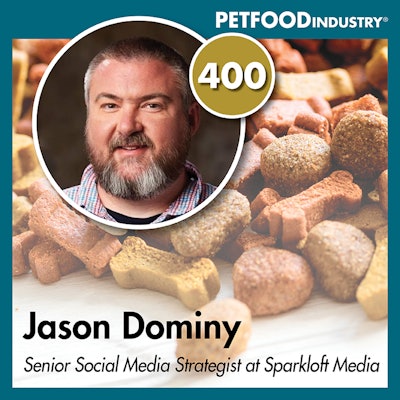
Sparkloft Media Senior Social Media Strategist Jason Dominy and I discussed all things social media: What consumers are expecting from their interactions with companies, how this marketing platform has grown and diversified, and how to avoid some of the pitfalls of interacting with your customers. Tune in for all the tips you need to succeed!
The below transcript is from Episode 13 of the Trending: Pet Food podcast, where I spoke with Senior Social Media Strategist of Sparkloft Media Jason Dominy about the key points of pulling together a successful social media strategy in the pet food space. You can find the episode at www.PetfoodIndustry.com/trending-pet-food-podcast, on SoundCloud or on your favorite podcast platform. This episode originally aired on July 20, 2022.
Lindsay Beaton – Editor, Petfood Industry magazine and Host, Trending: Pet Food podcast
Hello, and welcome to Trending: Pet Food, the industry podcast where we cover all the latest hot topics and trends in pet food. I'm your host and Editor of Petfood Industry magazine, Lindsay Beaton, and I'm here today with Sparkloft Media Senior Social Media Strategist Jason Dominy. Hi, Jason, and welcome!
Jason Dominy – Senior Social Media Strategist, Sparkloft Media
Hi, thank you. Thanks for having me.
Beaton: In case you’re not familiar with Jason or Sparkloft, here’s what you need to know. Jason started in the social media marketing space when it first began, and has worked in that digital focus both on the brand and agency sides for more than 10 years. He has managed and written content and social strategies for brands including Coca-Cola, McDonald’s, Wells Fargo, UPS and Chick-fil-A. In his free time, he enjoys hikes, is a landscape photographer, and plays with his dog, Kato.
As a social-first creative agency, Sparkloft Media has specialized in cutting-edge marketing and communications solutions since its inception in 2006. Equipped with powerful strategic insights and captivating creative executions, the agency adapts brands into memorable experiences on any platform, in the real world, the digital world, and the worlds we have yet to discover. Sparkloft is headquartered in Portland, Oregon, with offices in Atlanta, Georgia; Miami, Florida; and Washington, D.C.
Jason’s digital focus and knowledge of the social media landscape are why I’ve brought him on today to answer this question: What does a successful social media strategy look like in the pet space?
Jason, I want to dive right in by talking about how things have changed in recent years in terms of social media strategies, and really what the landscape looks like as we continue to head towards a more digital-centric society. What are some of the key differences in social media strategies now from, say, five years ago?
Dominy: One of the key differences is that five years ago, the social media strategy for most companies, including pet companies, was around educating consumers about their products specifically, so talking about their pet foods, talking about their toys, and the benefits and that sort of thing. And the trends now are around petfluencers, and the strategy behind making the consumers’ pets more a part of a brand's social media so that there's more buy-in from that consumer. So it shifted from, let me tell you about my products, to let's actually make this social media more a part of your daily lifestyle through kind of fun content that sits in your timeline.
Beaton: That seems like a pretty deep shift in terms of how companies need to communicate with their customers and potential customers. What are some of the ways that companies have had to go deeper? Brand storytelling is starting to be a significant thing in the pet space again, rather than a transactional relationship. It's more of a storytelling, you know, we want you to bring us into your homes and we want to be part of your family. How does that change the way social media feels from a company perspective? And then on the customer side as well? Is it much more of a — is it becoming a closer relationship than it used to be?
Dominy: Yeah, I agree with that. I believe that it's become a lot more organic, it's become a lot more like when you talk about storytelling, the storytelling sort of goes both ways in a sense that the consumer wants to tell their story of their pet and the company wants to tell the story of what they provide for those pets. And in many ways, that's the sort of shift of a brand making those consumers and their pets more a part of their story and making them more a part of the experience, because we've moved from a transactional society where it's just, I have a product, you have $5, give me $5, I give you product, where it's like, okay, well, I can buy that product from anywhere. Why would I buy it from you? And that's where the experience comes in, and the storytelling of why would I purchase that from you? Why would I be a part of this narrative that you've created? Whether it's, you know, a pet food brand, or a pet clothing brand, it's just about how do we make you more a part of the story?
And then for the consumer, it's with so much competition, they want to know that their purchase makes them feel good in some way, whether it's giving back to the Humane Society, or whether it's helping other shelters or adoption, they want to know that their purchase is helping their greater cause for their love of pets. So they both kind of are wanting to get something different out of that storytelling element. But regardless, that's the whole driver behind making this social media experience a lot more personalized, both for the brand and the consumer.
Beaton: I feel like social media used to mean maybe one or two different avenues, and now it's an umbrella term for a whole landscape of digital communication. What is the best way for a company to go about meeting their customers where they're at? How did they determine where to focus their social media efforts and where to find the people that they're really trying to connect with?
Dominy: That's a great question, especially as consumers have shifted where they are on social media greatly over the past five years. Five years ago, if you think about it, everyone was predominantly on one of the top platforms: Facebook, Instagram, Twitter. And now what you see is a lot more niche social media sites, a lot more, instead of Facebook on the whole Facebook groups, for instance. You find them on little niche platforms like Reddit, which is a place that five years ago I don't know that there would have been a lot of this audience on. But Reddit has become a really good niche platform. And so, as consumers have shifted from some of the larger social media platforms due to issues around privacy, or staying off it for political reasons, or you name it, fatigue, they are moving to a lot more of the smaller, niche platforms.
And the best way that a company can find out where their customers are at is by doing an audit of each of those platforms that they currently are on. What are those demographics for each of those platforms? What is the percentage of fans and followers on each of those platforms? And then thinking outside of that into some of these smaller niche platforms, like I mentioned. If you think about it, you want to be where your customers are the most. And what that means is, you don't necessarily need to be on all platforms, you just need to be where your customers are. So if you think that, you know, your target audience is, let's say 18 to 30, and it's around fun pet stuff, you might look at a niche platform like Tiktok, which is extremely popular, especially with pet influencers. So you might just look and see, what are other opportunities for us to be in the social media space, after you've sort of determined what those major social media platforms look like for you and your brand.
Beaton: What does that legwork look like for a social media team? Let's say you're a smallish to mid-size pet food company, you really don't have a lot of capital to have a huge social media team. Maybe you have one social media person, one person dedicated to this, and then you know, maybe they pull in marketing or advertising or whatever. What does the legwork look like for that one person? And if you have limited resources, where do you focus after you do that audit? Or even during the audit? Do you say, this is my demographic. I need to find out where they are, I'm just gonna roll with them. Is it better to pick a couple platforms and diversify a little bit? What have you seen in terms of smaller companies or mid-sized companies trying to deal with and navigate this kind of massive landscape where everybody is sort of all over the place online
Dominy: One of the advantages of a smaller company is that their fan base is going to be a lot more visible on social media and they're a lot more loyal. So if you've got a smaller company that's really successful, leveraging that audience to help them in terms of advocacy is a really good strategy. Another thing that is really helpful for that one-person social media team is to take a look at what their competitors are doing and see what seems to be working and what doesn't work; that will help you with some of that research in advance. And then last, one of the advantages, again, of a smaller company is that you can make that experience on social media a lot more personalized, so leveraging user-generated content, which is content that consumers themselves are creating on behalf of their pets, is a really good strategy. So maybe partnering with some of these folks, or creating surprise and delight campaigns, which are where you take some of your biggest fans and just surprise them with some sort of gift, some sort of swag. Maybe it's a free bag of dog food, maybe it's a free custom t-shirt. There are lots of ways that you can create brand advocacy for some of these smaller brands just by listening to your audience and paying attention to who your biggest fans are, and then rewarding them, which makes them a part of the overall storytelling experience for your brand.
Beaton: Let's talk about the interactivity a little bit more because it used to be — at least I had read somewhere at some point several years ago that it was — that there was about a 1/3-1/3-1/3 rule in terms of what you were supposed to do on social media, and it was 1/3 your content, 1/3 repurposing or promoting other people's content and then 1/3 interacting with your audience base. Is that still true? Or has social media become a lot more interactive in terms of expectation between companies and consumers? What are consumers looking for in terms of the content mix of a social media platform these days?
Dominy: I would say it's more a quarter your own content, half interactive and then one-quarter sharing and repurposing fans’ content. The interactive piece is the biggest predominant piece that should be in your strategy for a brand. And that's simply because consumers are very busy. They also have very short attention spans on social media because there's so much content out there, you have a very limited space, a very limited time to capture them and capture their attention. So it's more important than ever to create content that's interactive, that's engaging, that provides value, and that showcases them and their pet, to be successful. That's why I believe that maybe a fourth your content and half of that should be interactive, and helping make them a part of that story.
Beaton: What counts is interactive these days? Is it sitting on an account and talking back and forth with people? Is it doing things like whatever the current version of a Facebook Live or an Instagram Live video is? Do people like text, do people like videos, where are people at these days in terms of what they like on social media and what it means to be interactive on social media?
Dominy: So when I think of interactive, I think of you know, social media should be a conversation between two people. And I understand that; let's say that other person is a brand. It's still a person. And so that idea of social media as a conversation is starting to come back. And it's starting to become popular again, which I'm super excited about because I've always said that one-way social media is just marketing. It needs to be interactive, it needs to be a conversation between two people. So you talk about social listening, for example. That's the idea that we're going to spend some time as a brand, to listen to the conversations that are happening around our industry, and finding conversations that we can naturally and organically inject ourselves into those conversations or offer some value to those conversations in a way that's not forceful and doesn't it feel weird for me to be in. So that's social listening.
It's also trying to identify conversations that are happening around your brand. So let's say for instance, they didn't tag your brand but they mentioned your brand in a social media post. Well, if you're a brand, and you can identify where those conversations are and join those conversations, even if it's a negative experience and you can turn that negative experience into a positive experience, then that's a huge win for you and can go a long way to helping create loyalty. And then video: Video is still king right now in social media, so the more video, the better. We talked about live streaming and live video, live video interviews with pet owners with their pets, we talk about short form videos where we can highlight pets and their owners and talk a little bit about their stories. So maybe it's a shelter rescue, talk a little bit about that. And then last, providing some short-form videos that provide value to those consumers and pet lovers. Let's say, for instance, top five reasons why your dog might be scratching his paw. Creating some short videos that add value are always a really good play for pet brands, because they provide value in the user's timeline. And they're also really shareable, which helps extend the awareness of those brands.
Beaton: We're going to dive more into successes in a little bit, but I want to shift gears a little bit and talk about challenges and the ways things can go wrong. Because it's social media and we all know that things can most certainly go wrong. What are the top challenges you've seen companies deal with in regards to their social media strategies? And if there are any ways that companies typically go wrong, what are those ways, and then what kind of aftermath management do you have to do if you slip up and make one of these mistakes?
Dominy: There's a couple of things. One of the top challenges that I've seen companies deal, with just in terms of their social media strategy, is not having a strategy. It's just sort of posting, throwing stuff against the wall and seeing what works and what fits. It's also generalizing their audience instead of being very specific to who their target audience should be. They just create a social media strategy that's just for pet owners, and not being targeted and really specific about who that audience is and what they look like, what are their shopping habits. That is a really bad way to use social media because it just clutters up timelines. They're never really that successful. So I think just having a strategy goes a long way, and it's one of the ways that I see brands with the most challenges.
Another one is when they claim some sort of benevolent or altruistic platform — let's say for instance it's around whole foods or humane practices for how they pick their chicken — and then not following up with that and/or not providing some transparency about that to consumers. Now, more than ever, consumers are very cognizant about a lot of these issues and a lot of these treatment of animals in general, especially as it relates to what goes into pet food. So making sure that brands on social are transparent about that, and are really open to being honest about these ingredients for their pet foods, is a really important thing because you've seen in the past with, I think it was Blue Buffalo, who ran into some of these issues with not totally being transparent or being wrong in some cases. And the social media backlash from that can be really bad. And as you know, pet lovers are incredibly passionate, and so when they get behind anything it can really be a huge detriment to your brand.
Beaton: I feel like companies probably view social media as a double-edged sword and a pretty significant risk factor in terms of their business strategy for those kinds of reasons: One wrong move and it's all over the internet forever, one wrong interaction with a customer, one poorly timed ad. How do you see companies deal with that? And what is your advice for companies who think of social media, not as the enemy necessarily, but as a significant risk and something that they're tentative to really dive into? Because transparency is a growing thing in the pet food industry and people really do want to hear the stories of companies, but I can understand the reticence, especially with companies that have had a more traditional strategy in the past where they just want to sell their product. That's not good enough anymore. You have to sell your brand and you have to let customers get to know you. But I can understand how that feels like a pretty significant risk. So how do you help companies get over that feeling and really take the plunge into a full-bore social media presence?
Dominy: I think being respectful of social media in general. And that risk that you talk about is one of the key ways. And what that helps you do is it helps you create a strategy in advance so that you're more proactive than reactive. So we're going to create a good social media strategy for a client that takes into account all of the things that could be talked about with that brand, potentially, or already being talked about with that brand, and create a strategy on how we go to help talk about that with consumers.
The second thing is, one of the most important things that a brand can do in terms of their strategy is to create sort of a plan for when things do go wrong. And oftentimes, it's important to think about the fact that it's not if something will happen on social media, but when will it happen on social media? And how quickly can you take care of that and regain consumers’ confidence? One of the best ways to help with risk aversion is to create a really good, robust strategy, which is kind of what we do for clients. The second part of that is creating a crisis management plan, so that if something does go wrong we know exactly how to react to that. Remembering that if you think about putting yourself in their shoes, and again, pet owners are extremely passionate, they're simply looking out for the well-being of their pets. You as a pet brand should be thinking about the welfare of those pets. And so you're speaking the same language, it's just a matter of helping them understand what happened, being transparent about it, and what you're going to do about it in the future.
Social media doesn't have to be a scary thing. It can be an extension of who you and your employees are as a brand. And a lot of folks who work in the pet food industry are pet lovers themselves. So being an extension of that is not necessarily a bad thing on social media. That's why I think that another way that you can help tell the story of your brand and separate yourself with the strategy component is making your employees a part of that story that you're telling about your brand as well.
Beaton: That's very interesting, making your employees part of the story. What are some of the ways you've seen companies do that? And then let's talk about bigger picture. What are some of the big wins you've seen in social media in general — if a pet food company is looking for somebody to emulate, who is doing it right?
Dominy: One of the brands that I think is doing it right on social media, just in terms of advocacy on the whole, both with their employees and their consumer base is rover.com. rover.com is a pet sitter dog walker service, but one of the things that they do really well is they feature really good tips. They feature unique toys, they talk about their pets who are a part of their service, the owners of those pets, as well as the sitters and walkers themselves. So they clearly made their audience a part of their social media. And it looks really good, it's organic, it feels good. It creates customer loyalty and overall brand advocacy. They just do a really good job with it, as well as providing value by answering questions and those sorts of things.
Another one, I'm using a couple of bigger ones because those are the ones that are the most visible to consumers, is Chewy.com. Chewy gets an average of 1,000 likes or more on each of their Instagram posts, for instance, but they also do a lot of really good video. And again, very similar. They feature a lot of their customers, pets on social media. They provide value by answering questions like, can dogs eat mangoes, best tips for pet allergies. They also feature some of the owners’ social media, leveraging their user-generated content. So when a fan posts about their purchase from Chewy, whether it's on Instagram or Twitter, they leverage that for their own user generated content. And then lastly, they do a really good job of keeping a cultural presence. So for instance, on May 4, they had a really interesting Star Wars Day/May the Fourth be with you post which had a cat and a dog that looked like the Chewbacca characters from Star Wars. So being culturally relevant on their social media has been really good too.
I mentioned the importance of pet influencers. Now more than ever, pet influencers are really a key component of pet brands in general. Some of the largest pet influencers have millions and millions of followers. So an example would be like Jeff the Pomeranian. Jeff the Pomeranian has 10 million followers. Nala Cat has 4.3 million followers. Doug the Pug has close to 4 million followers. A lot of these pets have become huge influencers for a lot of these pet brands. And that's provided a completely different, unique experience for how brands connect on social media. So when I think of brands like Chewy, they're leveraging these pet influencers to extend the reach of their own social media. That's another key difference. A 2019 report found that eight out of 10 consumers purchase something after having seen it as a recommendation by an influencer. These pet influencers are a really huge part of the success of a lot of these larger pet brands’ social media.
Whether it's Chewy or Rover, those are some ones that I saw that do a really good job of sort of that strategy that I talked about: Making them and their pets a part of your story, providing value by answering questions and providing tips and tricks. And then lastly, making it interactive, listening to conversations that are happening around their brand and their pets.
Beaton: I'm not surprised by the pet influencers too much, because word of mouth is such a huge marketing strategy in the pet food space. And I think in a lot of different industries, people are more likely to try something if it's been recommended to them by somebody who they see as another person, right? Not necessarily completely linked to the company, but just to consumer themselves. What are some of the tips to make your social media space welcoming for those kinds of conversations for customers to come in and recommend products to each other without your interference at all? And just kind of making it a welcoming grassroots effort, I guess to get your products out there without you butting in and making it feel like a corporate strategy? What are some of the ways you can really make the space welcoming to have those kinds of conversations?
Dominy: One of the unique ways to leverage social media, I believe for a brand, is to provide a fan user base around whatever that thing is. So let's say for instance it is champion jumping horses. I think creating a Facebook group that specifically around that one niche thing as a brand, facilitating it, managing it and then just letting fans talk back and forth, injecting yourself when appropriate, I think that's a really good way to provide value. Bringing a lot of these passionate pet lovers together and providing resources and value to them is always a really good play, because they do reward you with their loyalty because they're getting value out of it as well. So I think just creating some of these smaller places and spaces and communities for brands is a really good play. You know, we talked about influencers — one pet brand, Champion Petfoods, they attributed more than 25 million impressions due to their partnerships with social media influencers. So identifying those influencers and what those communities look like, and maybe creating communities like that for your brand, could be really helpful.
Beaton: Let's say somebody's listening to this episode and they're in social media, they're in marketing, they're ready to take a look at their company's social media strategy and really dive into what might need to change what might need to update. What would you say is the one thing companies need to know about how to engage in social media today? What's the top thing they need to build their strategy off of in order to succeed?
Dominy: First and foremost, consumers are on social media, not generally to purchase products, not generally to find out about the best pet food for them. They're there on social media as an outlet and a relief from stress, to find out what their family is doing, to find out what their friends are doing. They're not necessarily there to hear about your product. Thinking about that, and thinking about that space as being an organic space where you yourself go as an outlet, away from the things that are stressful in your life goes a long way to helping you identify: What are the ways that you can join that timeline, without interfering, and in an organic way that feels natural, and it doesn't feel intrusive in their timeline? So I think that that's one of the most important things that you can do, is remember that consumers didn't log on to Facebook to find out what's the best dog food, they logged on to Facebook to find out what their friends are doing, what their families doing, what's going on in their town, those sorts of things. So how can you join that overall conversation in a more real, authentic and open way? That's one of the best ways that you can use social media as a brand.
Beaton: I want to thank you so much for your insights, Jason. As pet owners continue to find new ways to engage with the brands they do business with, I think it's really important to stay on top of all the pitfalls and possibilities out there in the digital space.
Before we wrap up today, let's do a little plug: Where can people find you and where can people find Sparkloft Media?
Dominy: I'm on Instagram @jasondominy, it features a lot of hiking adventures with my dog Kato. And then Sparkloft: We are on all social media, but especially Instagram @sparkloftmedia. We talk a lot about the things that are working on social media as a social media-first agency, and we look forward to seeing you.
Beaton: That's it for this episode of Trending: Pet Food. You can find us on www.PetfoodIndustry.com, SoundCloud or your favorite podcast platform. You can also follow us on Instagram @trendingpetfoodpodcast. Once again. I'm Lindsay Beaton, your host and Editor of Petfood Industry magazine, and we'll talk to you next time. Thanks for tuning in!
















